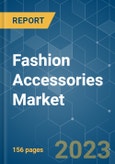The fashion industry is highly competitive and requires continuous innovation and development, especially in the case of product design and improvement, with changing consumer trends driving the growth of the fashion accessories market. There is a growing contribution to the market from developing countries such as India, owing to the shift in consumer behavior, growing purchasing power, increasing urban population, etc. According to 'the United Kingdom Economic Accounts Time Series Datasheet,' the household final consumption expenditure on clothing and footwear in the United Kingdom witnessed a growth of 16.2% during the current year. Additionally, the growing penetration of the internet, social media, and e-commerce are now providing consumers in tier 2 and below cities access to top brands' products.
With the increasing number of brand-conscious consumers worldwide, major players are adopting strategies to draw consumers' attention by introducing new products in different segments worldwide. Furthermore, growing fitness trends and fashion consciousness celebrity endorsements, public service directives, online marketing strategies, and company incentives have also influenced the urge to keep up with the latest fashion trends and maintain fitness, factors which in turn have fueled the purchase of trendy fashion and sports accessories via various retail channels among which e-commerce platforms have been the most preferred medium of purchase.
Fashion Accessories Market Trends
Premiumization Driving the Fashion Accessories Market
Customers, especially millennials and Generation Z, are increasingly open to premium fashionable clothing and are willing to experiment with various branded premium fashion accessories owing to evolving fashion perceptions accompanied by high disposable income and rising exposure to global fashion trends. Also, according to the Bureau of Labor Statistics, customers aged 35 to 54 have the highest spending power for clothes in the United States in the current year. Increased socialization and growing exposure to branded accessories across various retail channels have influenced consumers buying decisions, and they are tempted to spend more on premium fashion accessories.Further, customers' lifestyles substantially changed over the last decade with the impact of urbanization and digitalization in developing economies. The middle-class population is now more open to spending on fashion wear and personal grooming products, which in turn is anticipated to drive market growth across key regions such as the Asia Pacific and the Middle East. Moreover, these premium brands are also tapping into the growing demand for modest wear across regions like India, Saudi Arabia, and other regions, gaining traction among consumers willing to address both spiritual and stylistic requirements. Globally, the modest fashion industry has reached to USD 277 billion mark (State of the Global Islamic Economy Report 2020/21), with Saudi Arabia representing one of the major market shares. Recently, in 2022, Gucci launched its premium Nojum - a modest collection explicitly designed for the unostentatious needs of the Middle East, including Saudi Arabia.
Asia-Pacific is the Fastest Growing Market
The growing attraction for the luxury lifestyle, high purchasing power, and the influence of celebrity endorsement is driving the market growth in the region. A rapid economic expansion occurs across Asia, with countries such as India and China taking center stage. As a result, India and China are becoming more attractive markets for fashion accessories outside the Western world. To gain momentum around offline stores, retailers in this region are leveraging technology to enhance the in-store experience with digital marketing displays and checkout. The strong economic growth and rising tech-savviness will make the region the next big opportunity for fashion accessories during the forecast period.Moreover, consumers are much more conscious about their health than they used to be and are taking life-changing steps. As per a survey conducted in association with Japan Sports Agency in November 2021 in Japan, 15.1% of respondents in their twenties stated that they used fitness clubs. Similarly, in Australia, 45.80% of people aged between 25-35 years have a habit of going to gyms, fitness clubs, and leisure centers. Hence, due to the above factors, the fashion accessories market is expanding along with the increase in sports apparel demand across the Asia-Pacific region.
Fashion Accessories Market Competitor Analysis
The market studied is highly competitive, with the presence of key players competing for major market share and small regional players catering to a small region to capture the market share. Kering Group, LVMH Moet Hennessy Louis Vuitton, Hermes International S.A., Inditex, Industria de Diseño Textil S.A., and H & M Group are major players in this market. These players are now focusing on social media platforms and online distribution channels for their product's online marketing and branding to capture the maximum customers' attention. Major players focus on leveraging the opportunities posed by innovation in the market to expand their product portfolios to cater to the requirements of various product segments by providing unique and attractive high-quality products offering, along with the increased convenience of purchase.Additional benefits of purchasing the report:
- The market estimate (ME) sheet in Excel format
- 3 months of analyst support
This product will be delivered within 2 business days.
Table of Contents
Companies Mentioned (Partial List)
A selection of companies mentioned in this report includes, but is not limited to:
- Giorgio Armani S.p.A.
- LVMH Moet Hennessy Louis Vuitton
- Dolce & Gabbana
- Kering Group
- Tapestry Inc.
- Fossil Group Inc.
- Inditex, Industria de Diseno Textil S.A
- Prada SpA
- Chanel SA
- Luxottica Group SpA
- Tommy Hilfiger
- House of Titan
- Hermes International S.A.










